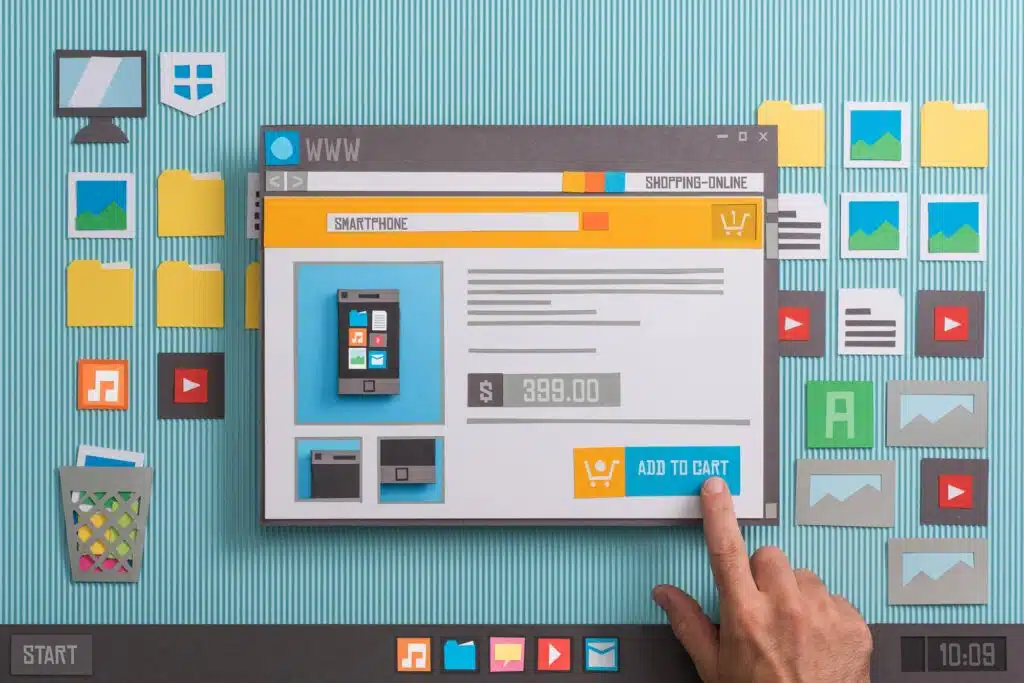When it comes to small business web design, having a professionally crafted website isn’t just a luxury—it’s a necessity for companies looking to thrive in the digital marketplace. Your website serves as a 24/7 digital storefront, continuously working to attract, engage, and convert potential customers. While many small businesses have an online presence, not all websites deliver results. To truly stand out and drive meaningful customer engagement, your small business web design needs to incorporate specific features that enhance user experience, build trust, and facilitate conversions.
Why You Should Invest In Small Business Web Design
Investing in professional small business web design is crucial for establishing a strong digital presence and staying competitive in today’s market. A well-designed website not only enhances your brand’s credibility but also serves as a powerful marketing tool that can significantly impact your bottom line. Studies show that users form opinions about websites within milliseconds, making first impressions critical. Professional web design ensures your site looks polished, functions smoothly, and effectively communicates your value proposition to potential customers. Moreover, a professionally designed website can improve your search engine rankings, increase conversion rates, and provide valuable analytics to help you understand and better serve your target audience. While DIY website builders might seem cost-effective initially, they often lack the sophisticated features and customization options that can truly set your business apart in a crowded digital landscape.
Professional small business web design encompasses crucial technical aspects like mobile responsiveness, security measures, and optimal loading speeds – factors that directly influence user experience and search engine rankings. By investing in quality web design, you’re not just creating a digital presence; you’re building a robust foundation for your business’s online success and future growth.
5 Essential Small Business Web Design Features
The following essential features transform basic small business web design into an effective customer engagement platform. These critical elements combine to create exceptional user experience, establish trust, and drive conversions. Each component, from user experience-focused design to search engine optimization, serves a specific purpose in maximizing website effectiveness and achieving business objectives. Implementation of these key features ensures optimal visitor attraction, engagement, and conversion rates.

User Experience Focsued Elements
User experience (UX) focused elements are the cornerstone of effective small business web design. These features work together to create an intuitive, engaging, and frustration-free browsing experience for your visitors.
A well-crafted UX design considers how users interact with your website, ensuring they can easily find information, navigate between pages, and complete desired actions. By prioritizing user experience, you not only keep visitors on your site longer but also increase the likelihood of converting them into customers.
High-Quality Multimedia
High-quality multimedia elements are essential for creating an engaging and professional website. This includes crisp, properly sized images that showcase your products or services, professional videos that demonstrate your expertise, and interactive elements that encourage visitor engagement. When implementing multimedia, it’s crucial to optimize file sizes to maintain fast loading speeds while preserving quality. Consider using a mix of product photos, team pictures, infographics, and short video clips to break up text and create visual interest. Remember to include alternative text for images to ensure accessibility and improve SEO performance. Well-chosen multimedia can dramatically increase time spent on your site and help convert visitors into customers.
Simple Navigation
Simple navigation is a fundamental aspect of effective small business web design that can make or break the user experience. A well-structured navigation system helps visitors quickly find what they’re looking for, reducing frustration and bounce rates. The key is to implement a clean, logical menu structure that guides users through your site’s content hierarchy. Best practices include using clear, descriptive labels for menu items, maintaining consistent navigation across all pages, and ensuring that no important page is more than three clicks away from the homepage. For small business web design, this often means organizing content into broad categories with intuitive subcategories, incorporating a prominent search function, and including a visible “Home” button or logo link. The goal is to make the user’s journey through your site as seamless as possible, encouraging them to explore more content and ultimately take desired actions.
Helpful Call to Action Buttons
Effective call-to-action (CTA) buttons are crucial elements in small business web design that guide visitors toward desired actions. These buttons should be visually distinctive, using contrasting colors and clear, action-oriented text that creates a sense of urgency or value (e.g., “Get Started Today,” “Schedule Your Free Consultation,” or “Download Our Guide”). Strategic placement of CTAs throughout your website – particularly above the fold, at natural decision points, and at the end of compelling content – helps maximize conversion opportunities. The buttons should be large enough to be easily clickable on mobile devices, yet proportionate to your overall design. A/B testing different CTA variations can help optimize their effectiveness and improve conversion rates. Remember, each page should have a primary CTA that aligns with the specific stage of the customer journey, making it clear what action you want visitors to take next.
Fast Page Load Speeds
Users expect websites to load instantly, and page speed has become a defining factor in website success. Research shows that 53% of mobile users abandon sites that take longer than three seconds to load, making speed optimization essential for retaining visitors.

To achieve optimal loading times, implement techniques such as image compression, browser caching, minimizing code, and choosing a reliable hosting provider. Regular speed testing using tools like Google PageSpeed Insights can help identify and address performance bottlenecks. Additionally, consider implementing lazy loading for images and videos, which loads content only as users scroll down the page, improving initial load times. The impact of page speed on conversions is significant – even a one-second delay in page response can result in a 7% reduction in conversions, making it a crucial factor in your website’s success.
Important Company Information
Providing essential company information on your website is crucial for building trust and facilitating customer engagement. Your small business web design should prominently display key business details that visitors commonly seek. This information serves as the foundation of your online presence, helping potential customers understand who you are, what you offer, and how to reach you. When strategically incorporated into your website design, these essential business details not only enhance credibility but also improve user experience by making it easy for visitors to find the information they need quickly.
Contact Information
Clear and accessible contact information is a fundamental element of effective small business web design. Your contact details should be prominently displayed in multiple locations, including the header, footer, and a dedicated contact page. Essential contact elements include your business phone number, email address, and contact form for inquiries. The contact form should be simple yet comprehensive, requesting only necessary information to avoid overwhelming potential customers. Consider implementing click-to-call functionality for mobile users and integrating live chat options for immediate assistance. Make sure your contact information is consistent across all platforms and verify that all contact methods are regularly monitored to ensure prompt responses to customer inquiries. Remember to include social media links as alternative contact channels, as many customers prefer to reach out through these platforms.
Hours of Operation
Your hours of operation should be easily visible in the footer and contact page, and should be regularly updated to reflect any changes in business hours, holiday schedules, or special circumstances. For businesses with multiple locations or varying hours by department, consider creating an organized table or dropdown menu to display this information clearly. Include time zones for online businesses or those serving multiple regions, and consider implementing a real-time status indicator showing whether you’re currently open or closed. This transparency in operating hours helps manage customer expectations and reduces unnecessary contact attempts during off-hours.

Business Description
Your business description serves as the foundation of your online presence, telling your story and connecting with potential customers. Start with a compelling elevator pitch that quickly communicates what makes your business special, then delve deeper into your company’s history, expertise, and the specific problems you solve for customers.
Include information about your team’s qualifications, industry experience, and any specialized knowledge that sets you apart from competitors. The description should be written in a tone that reflects your brand voice while remaining professional and accessible. Remember to update this content regularly to reflect your business’s growth, new services, or evolving market focus. A well-crafted business description helps visitors understand not just what you do, but why they should choose your business over others.
Location
Your business location should be prominently featured in your small business web design, as it helps establish local credibility and improves local search visibility. Include your full physical address, preferably with an embedded Google Maps integration that allows visitors to easily get directions. For businesses with multiple locations, create dedicated location pages with unique content about each facility, including parking information, nearby landmarks, and any location-specific services. Consider adding area-specific photos and details about the local community to help potential customers feel connected to your business. If you operate primarily online, clearly communicate your service area and any geographical limitations. This information not only helps with local SEO but also builds trust with potential customers who want to know where you’re based, even if they never visit your physical location.
Informative Content
Informative content is a critical component of effective small business web design, serving as the primary medium for communicating value to your audience and establishing industry authority. Quality content helps educate visitors about your products or services, addresses common customer pain points, and provides solutions to their challenges. Well-crafted content not only helps with search engine optimization but also keeps visitors engaged and encourages them to spend more time exploring your website. When developing content for your small business web design, it’s essential to focus on creating valuable, relevant, and easily digestible information that resonates with your target audience’s needs and interests.
Utilize Different Content Formats
Smart businesses leverage multiple content formats to capture and maintain their audience’s attention. Your website should feature a strategic blend of written content, videos, infographics, podcasts, and interactive elements that speak to different audience preferences. While some visitors gravitate toward in-depth blog posts, others connect better with visual guides or video tutorials. Downloadable resources like whitepapers, ebooks, and checklists add extra value and help establish authority. Interactive elements such as calculators, quizzes, or configurators create engaging, personalized experiences that keep visitors on your site longer. By optimizing all content for both desktop and mobile viewing, you ensure accessibility across devices. Regular performance tracking reveals which formats resonate most with your audience, helping shape future content decisions.
Make Sure to Write for Humans not Search Engines
While SEO is crucial for visibility, writing primarily for search engines often results in awkward, keyword-stuffed content that alienates human readers. The key is to create valuable, engaging content that naturally incorporates relevant keywords while maintaining a conversational, authentic tone. Focus on addressing your audience’s needs, questions, and pain points with clear, well-structured content that provides real value. When you prioritize human readers, you’ll find that search engines naturally recognize and reward quality content. This approach leads to better engagement metrics, longer time spent on page, and ultimately, higher search rankings. Remember that search engines are becoming increasingly sophisticated at understanding natural language and user intent, making keyword stuffing and other artificial optimization techniques not only ineffective but potentially harmful to your site’s performance.
Create Content Frequently
Regular content creation is vital for maintaining an effective small business web design and keeping your site fresh and engaging. A consistent publishing schedule signals to both visitors and search engines that your website is actively maintained and relevant. Aim to publish new blog posts, articles, or updates at least 2-3 times per month, focusing on topics that provide value to your target audience. Fresh content not only improves your search engine rankings but also gives customers a reason to return to your site regularly. When creating new content, maintain a balance between evergreen resources and timely updates, ensuring that each piece aligns with your overall small business web design strategy and business goals. Remember to promote new content through your social media channels and email newsletters to maximize its reach and impact.
Trust Elements
Website visitors are increasingly cautious about where they spend their money and share their information. Trust elements serve as powerful psychological triggers that help overcome this natural skepticism. These essential website components provide tangible evidence of your business’s legitimacy, expertise, and track record of success. When strategically implemented throughout your website, trust elements create a foundation of credibility that encourages visitors to confidently engage with your business and take desired actions. From third-party validations to customer testimonials, each trust indicator plays a vital role in building confidence and fostering long-term customer relationships.
Certifications
Professional certifications and industry credentials are crucial trust signals in small business web design. Display relevant certifications prominently, whether they’re industry-specific qualifications, security certifications like SSL, or professional memberships.

These credentials demonstrate your expertise, commitment to industry standards, and dedication to maintaining high-quality service. Include certification logos in your footer or dedicated credentials section, ensuring each is clickable and links to verification sources when possible. This transparency helps build trust with potential customers and distinguishes your business from competitors who may lack similar qualifications.
Reviews
Customer reviews are powerful social proof elements that can significantly influence purchasing decisions. Integrate authentic customer reviews from platforms like Google Business Profile, Yelp, or industry-specific review sites directly onto your website. Consider implementing a dedicated reviews section that showcases both positive feedback and your constructive responses to any concerns. Real reviews help build credibility, provide valuable insights into customer experiences, and can improve your local SEO rankings. To maximize the impact of reviews, display star ratings, verified purchase badges, and date stamps, and regularly encourage satisfied customers to share their experiences. Consider implementing a review management system that helps collect, moderate, and display reviews effectively while maintaining transparency and authenticity.
User-Generated Content
When customers share their experiences through photos, stories, and creative content, it creates an authentic narrative that resonates with potential buyers. Implementing a dedicated space for user-generated content (UGC) not only provides social proof but also reduces the burden of content creation while building a vibrant community around your brand. Consider launching hashtag campaigns or creating interactive galleries where customers can showcase their experiences with your products or services. This approach to content curation helps establish trust, encourages engagement, and provides potential customers with relatable, real-world examples of your offerings in action. Remember to establish clear guidelines for submissions and obtain proper permissions to maintain content quality and protect your brand reputation.
Search Engine Optimized Pages
Search engine optimization (SEO) is a critical component of small business web design that can significantly impact your online visibility and customer acquisition. Effective SEO strategies help your website rank higher in search engine results, making it easier for potential customers to find your business when searching for relevant products or services. While SEO encompasses many technical and content-related elements, the core objective is to align your website with both search engine requirements and user expectations. This creates a foundation for sustainable organic traffic growth and improved online presence.
Conduct Keyword Research
Keyword research is the foundational step in creating an SEO-optimized website. Start by identifying primary keywords that align with your business offerings and industry focus. Use tools like Google Keyword Planner, SEMrush, or Ahrefs to analyze search volumes, competition levels, and related search terms. Pay attention to seasonal trends and local search variations to understand when and where your target audience is most active. Create a comprehensive keyword list that includes both broad industry terms and specific product or service-related phrases. Prioritize keywords based on relevance, search volume, and competition level, then strategically incorporate them into your website’s content structure.
Optimize for Long-Tail Keywords
Long-tail keywords are specific, often longer phrases that visitors use when they’re closer to making a purchase or seeking detailed information. While these keywords typically have lower search volumes, they often lead to higher conversion rates because they target users with specific intent. Focus on incorporating natural, conversational long-tail keywords that match how your customers actually search for your products or services. Create dedicated content pages that thoroughly address these specific queries, providing comprehensive information that satisfies user intent. Long-tail keyword optimization also helps you capture featured snippets and voice search results, as these searches often take the form of questions or detailed phrases. Remember to maintain a natural writing style while addressing these specific search terms, ensuring your content remains valuable and engaging for human readers.

Optimize Meta Tags
Meta tags play a vital role in small business web design by providing search engines with essential information about your web pages. For effective small business web design, each page should have a unique, descriptive meta title that incorporates your primary keyword while staying under 60 characters.
Meta descriptions, though not direct ranking factors, should be compelling 150-160 character summaries that showcase your small business’s value proposition and encourage clicks. While optimizing these elements for small business web design, maintain a natural writing style and ensure your meta content accurately represents each page’s purpose. Additionally, optimize other meta elements like header tags (H1, H2, H3) and image alt text, creating a cohesive optimization strategy that enhances both search visibility and user experience.
Make Your Website Mobile-Friendly
Ensuring your website is fully optimized for mobile devices is non-negotiable. Your small business web design must implement responsive design principles that automatically adjust layouts, images, and functionality to provide seamless experiences across all screen sizes. This includes using flexible grids and layouts, optimizing image sizes for faster mobile loading, ensuring touch targets are appropriately sized and spaced, and testing your site across various devices and browsers. Mobile optimization should also consider factors like font size readability, button placement for thumb-friendly navigation, and simplified menu structures. With mobile devices accounting for a significant portion of web traffic, a mobile-friendly design isn’t just about convenience – it’s essential for maintaining competitive advantage and satisfying search engine requirements for mobile-first indexing.
Small Business Web Design with Voyager Marketing
Having a well-designed, engaging website isn’t just an option—it’s essential for business success. By implementing these 5 crucial web design features, you can create a powerful online presence that not only attracts visitors but converts them into loyal customers. However, designing and optimizing a website that drives real results requires expertise, time, and continuous attention to evolving best practices.
Don’t let a subpar website hold your business back. At Voyager Marketing, our team of experienced web designers and digital strategists can help you create a stunning, conversion-focused website that incorporates all these essential features and more. We understand the unique challenges small businesses face and specialize in delivering custom web design solutions that drive meaningful results.
Ready to transform your online presence? Contact Voyager Marketing today for a free consultation and let’s discuss how we can create a website that truly works for your business. Together, we’ll build a digital foundation that attracts, engages, and converts your ideal customers.